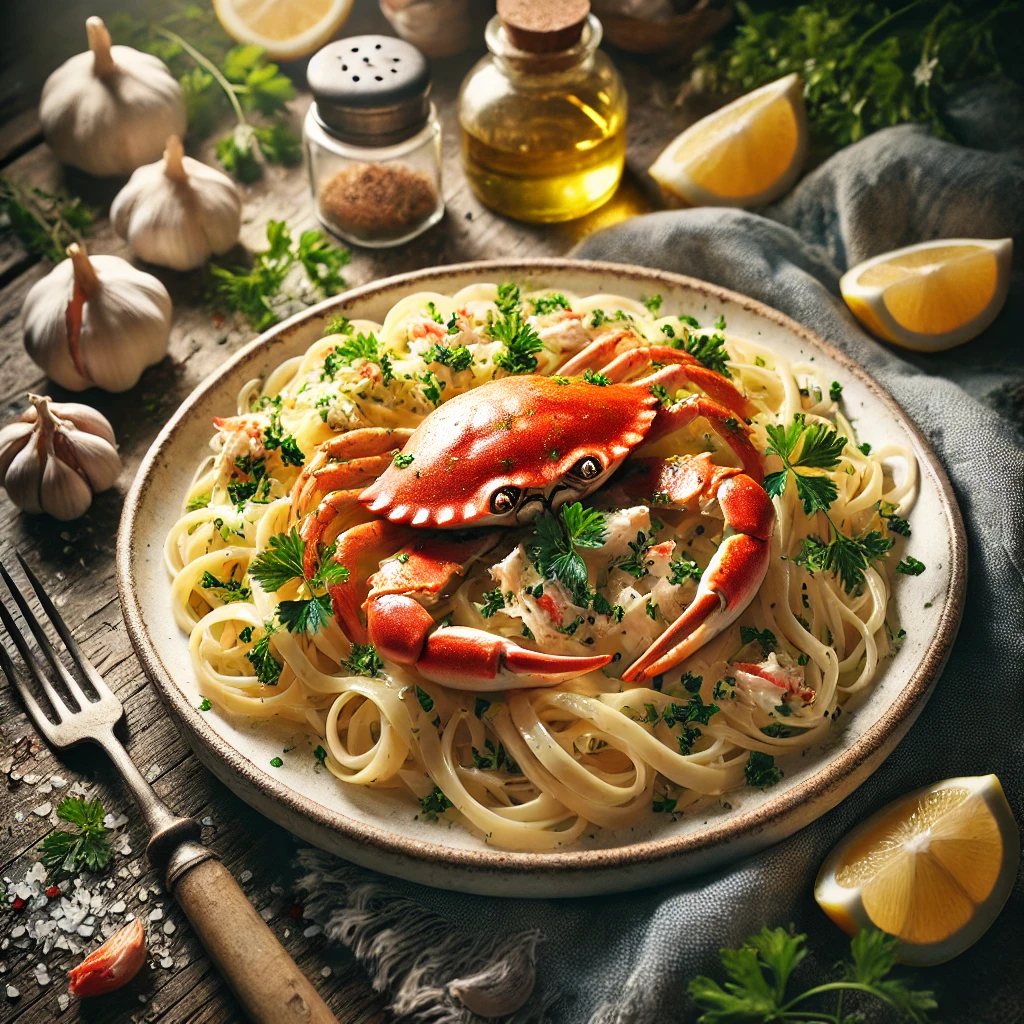Choosing Fresh Crab for Your Pasta Dishes
Here is a good recipe for a good Oven-Baked Crab Legs Recipe for a Tasty Feast.
Introduction
Fresh crab has the ability to transform pasta dishes from ordinary to extraordinary. Its delicate, sweet flavor and succulent texture make it an ideal choice for elevating pasta recipes, infusing them with the essence of the sea. However, the choice between fresh, frozen, or canned crab can be overwhelming. Understanding the value of fresh crab and how to choose it will ensure that your pasta dishes are of the highest quality, offering a depth of flavor that other options simply cannot match.
The Importance of Freshness in Crab
Fresh crab imparts a superior taste that canned or frozen alternatives struggle to replicate. When crab is fresh, its meat is tender and slightly sweet, with a texture that beautifully complements the firmness of pasta. On the contrary, using less-than-fresh crab can result in a rubbery texture and a muted flavor profile, diminishing the overall impact of your dish. Fresh crab not only enhances the taste but also brings an authentic seafood aroma that enriches the dining experience, making your pasta dishes stand out.
Different Types of Crab for Cooking
Not all crabs are created equal, and different varieties offer unique flavors and textures suitable for different pasta dishes:
- Blue Crab: Known for its sweet and delicate meat, blue crab is a favorite in light pasta dishes where the crab’s natural flavor can shine. It’s perfect for simple lemon and butter sauces or light cream bases.
- Dungeness Crab: With its meaty and slightly nutty flavor, Dungeness crab is ideal for more robust pasta dishes. Its substantial texture pairs well with tomato-based sauces, adding a hearty element to the meal.
- King Crab: King crab has rich, firm meat that adds a luxurious touch to pasta dishes. Its intense flavor stands up well to heavier, cream-based sauces, making it an excellent choice for indulgent recipes.
When to Choose Fresh Crab Over Frozen or Canned Crab
Fresh crab is the best choice when you want to highlight the natural, delicate flavors of seafood. Fresh crab’s texture is softer and more succulent than that of frozen or canned varieties, which may become tough or lose flavor during preservation. However, if fresh crab is not available, frozen crab can serve as a practical substitute. It retains much of its flavor if properly flash-frozen and is particularly useful in recipes where crab is mixed with other strong ingredients. Canned crab should be a last resort; it works best in recipes with bold sauces that can mask its often briny taste.
How to Identify Fresh Crab at the Market
To ensure you’re purchasing the freshest crab, look for these key indicators:
- Visual Cues: The shell of a fresh crab should be bright and glossy, without discoloration or cracks. For live crabs, movement is a clear sign of freshness—avoid any that appear lethargic or still.
- Smell Test: Fresh crab has a clean, oceanic scent. Avoid any crab that smells overly fishy or sour, as this indicates it is past its prime and may affect the flavor and safety of your dish.
Buying Live Crab vs. Cooked Fresh Crab
Purchasing live crab offers the freshest option, allowing you to control the cooking process and ensuring the meat remains tender. However, buying live crab requires preparation and cooking skills, as you’ll need to clean and cook it yourself. Pre-cooked fresh crab, available in some markets, offers a convenient alternative. This option saves time and can still deliver excellent flavor, as long as it has been freshly cooked and properly chilled.
Seasonality and Availability of Fresh Crab
Crab is best when it is in season, as the flavor and quality are at their peak. Different types of crab have distinct seasons:
- Dungeness Crab: In season from November through June, it’s at its freshest during the winter months.
- Blue Crab: Typically available from late spring through early fall, this crab is best enjoyed in summer dishes.
- King Crab: Harvested in the colder months, King Crab is usually freshest from October to January.
Being aware of these seasons helps you choose the best crab when it’s most abundant and flavorful.
Sustainability Considerations When Choosing Crab
When selecting crab, it’s important to choose options that are sustainably sourced to protect marine ecosystems. Look for certifications such as the Marine Stewardship Council (MSC) label, which indicates the crab was caught using sustainable practices. By supporting sustainable fisheries, you contribute to the conservation of crab populations and help ensure that this culinary treasure remains available for future generations.
Preparing Fresh Crab for Pasta Dishes
Once you’ve secured fresh crab, preparing it correctly is crucial for optimal flavor. If using live crab, start by boiling it in salted water until the shell turns bright red. After boiling, allow the crab to cool before cracking open the shell to extract the meat. Be sure to clean the crab thoroughly, removing the gills and any inedible parts. If using pre-cooked fresh crab, gently rinse it and check for any remaining shell fragments. Proper preparation ensures that the crab meat remains tender and flavorful when added to your pasta dish.
Best Pasta Pairings and Sauces for Fresh Crab
The type of pasta you choose can enhance the texture and flavor of your crab dish:
- Linguine or Spaghetti: Long pastas work well with light, oil-based sauces, allowing the crab to be the star of the dish.
- Fettuccine: This flat pasta is perfect for creamy sauces that coat the noodles, complementing the crab’s delicate flavor.
- Penne or Rigatoni: Tube pastas are excellent for holding onto thick, tomato-based sauces that pair well with robust crab varieties like Dungeness.
Sauce selection is also important. For a light and refreshing meal, a lemon butter or garlic olive oil sauce pairs wonderfully with crab. For a richer option, try a white wine cream sauce or a spicy tomato sauce to add depth and complexity.
Common Mistakes to Avoid When Cooking Crab Pasta
- Overcooking Crab Meat: Overcooked crab becomes tough and chewy, losing its delicate flavor. Cook crab gently, just until warmed through, especially if it is pre-cooked.
- Improper Seasoning: Avoid overwhelming the crab’s flavor with too many strong spices. Instead, use light herbs like parsley or basil and mild seasonings such as lemon zest.
- Using Poor-Quality Crab: Ensure the crab is fresh or high-quality frozen. Low-quality crab can result in an unappealing texture and taste.
Alternatives When Fresh Crab Is Unavailable
If fresh crab is unavailable, high-quality frozen crab can be a good substitute. Look for crab that has been flash-frozen, as this preserves flavor and texture. Another alternative is to use shrimp or lobster, which can provide a similar flavor profile and texture when fresh crab is not an option.
Health Benefits of Using Fresh Crab in Cooking
Crab is not only delicious but also nutritious. It is a low-fat source of protein, rich in omega-3 fatty acids, which support heart health. Crab also provides essential vitamins and minerals such as vitamin B12, zinc, and selenium, contributing to immune function and energy levels. Incorporating fresh crab into your pasta dishes can help create a balanced and health



1 thought on “Choosing Fresh Crab for Your Pasta Dishes”